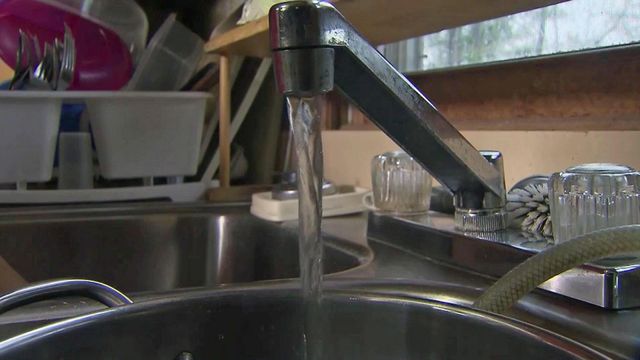Testimony shows DHHS doctor opposed move to declare wells near coal ash safe
One of the state's top health officials told environmental lawyers last week that she opposed a multi-agency decision in March to declare hundreds of private wells near coal ash ponds safe, despite drinking water that exceeded a threshold for a cancer-causing contaminant.
Posted — UpdatedMore than 200 well owners received letters in March rescinding advisories from nearly a year earlier that they avoid using their water for cooking and drinking. The letters, sent jointly by the Department of Health and Human Services and the Department of Environmental Quality, noted recipients' water was "as safe to drink as water in most cities and towns across the state and country."
"The timing wasn't what I recommended," Davies said, "and I felt that water in public water systems were safer."
Instead, she and her colleagues wanted to wait to determine the contamination's source – either Duke's coal ash ponds or natural sources – to provide well owners with more context. It's a question regulators at DEQ are currently trying to answer.
But after voicing this opposition with her superior, Public Health Director Dr. Randall Williams, she said he expressed concern about the strain on homeowners as well as potential backlash from state lawmakers.
"There was discussion in the General Assembly about passing legislation to restrict the Division of Public Health's ability to work in the area of well water," Davies said.
'Somebody needs to resign'
State officials began testing hundreds of wells within 1,500 feet of Duke coal ash basins in March 2015 as part of the 2014 Coal Ash Management Act. Using a process established by the state's groundwater monitoring law, a team of toxicologists at DHHS set a "health screening" level for hexavalent chromium of 0.07 parts per billion – a threshold many of the wells exceeded.
Davies told lawyers last week she would not drink the water from many of the tested wells, some of which showed hexavalent chromium levels higher than 10 or 20 parts per billion. Nor would she recommend her patients drink the water.
When asked whether she felt the letter supported the DHHS mission "to protect the health and safety all North Carolinians," she replied: "No."
Deborah Graham, a well owner near Duke's Buck Steam Plant in Rowan County who received a letter declaring her water safe to drink, said her original do-not-drink advisory showed the state was taking steps to protect her and her neighbors. She's been dismayed by the state's new advice and the transcript from Davies, which she said "reveals that the state has continued to twist the data and cover up important information."
"We need the truth about our water," Graham said in a phone interview Friday.
After reviewing the transcript, Graham said Williams' decision to send the letter despite opposition from his staffers was "a breach of public trust."
"I think somebody needs to resign, because they are not protecting the public health of North Carolinians," she said. "For him to go against his own experts is a slap in our face."
DHHS spokeswoman Alex Lefebvre said Friday no one from the department was available for comment on the transcript. But DHHS and DEQ have continued to point out that wells that received letters meet federal drinking water standards and are as safe as most public water systems.
The U.S. Environmental Protection Agency regulates drinking water only for total chromium at 100 parts per billion. Total chromium can include hexavalent chromium and less harmful forms of the element.
The stance by DHHS and DEQ has drawn criticism from environmental groups, who have accused the agencies of glossing over the risk posed by the well water. Catawba Riverkeeper Sam Perkins, whose organization is a party to the SELC lawsuit, said the transcript shows a lack of due diligence in putting together the new guidance, as well as the impacts of outside pressure not rooted in science.
"That's really concerning to see and confirms our concerns of politics having so much influence on this process," Perkins said, noting the original do-not-drink advisories provided well owners with much-needed clarity. "I wish we could get that restored."
Agencies remain tight-lipped over decision
The SELC declined to comment beyond the release of the transcript.
Officials with DEQ did not respond to requests for comment.
Although DHHS staff were unavailable to answer questions Friday, agency spokeswoman Kendra Gerlach called the transcript "misleading" and criticized the SELC for releasing "partial information before our citizens have the complete facts."
Gerlach also did not respond to her claim Friday that the wells in question meet California's drinking water regulations.
That claim is incorrect.
After months of demanding answers, Graham said she and another well owner were able to meet with officials from DHHS and DEQ, as well as Sen. Andrew Brock, R-Davie, to discuss the state's guidance. Her property and hundreds of others across the state are still receiving bottled water provided by Duke, although the company has noted that solution is temporary.
"That was the first time we felt like our voices had been heard," Graham said of the meeting.
Given what the transcript reveals about the internal disagreements about well water safety, she said, it's more important than ever that Duke continues to provide her and her neighbors with water – at least until they find another solution.
"When we see the water on Dukeville Road, it is like Christmas," Graham said.
• Credits
Copyright 2024 by Capitol Broadcasting Company. All rights reserved. This material may not be published, broadcast, rewritten or redistributed.





